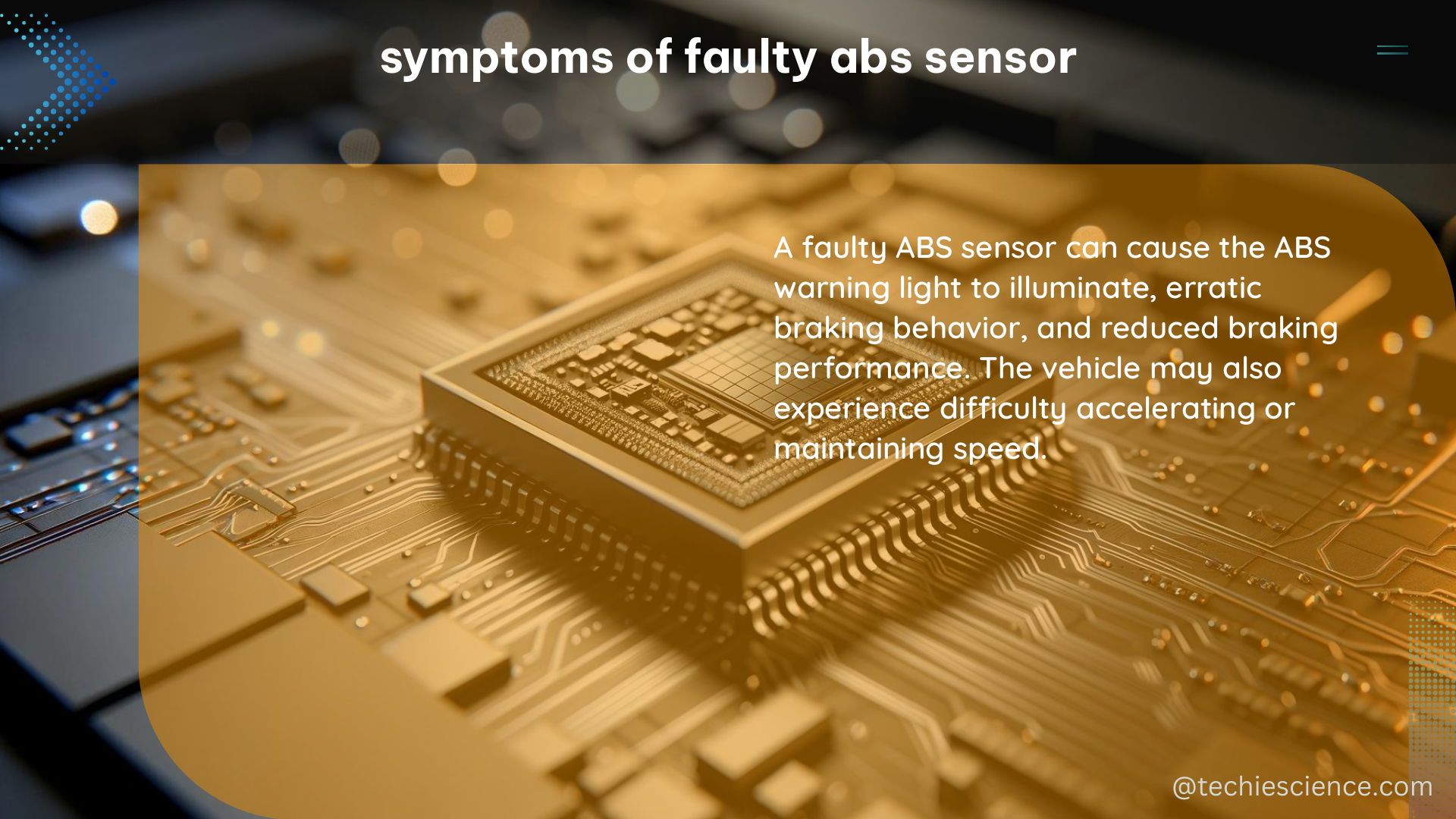The anti-lock braking system (ABS) is a crucial safety feature in modern vehicles, designed to prevent the wheels from locking up during sudden braking. At the heart of this system lies the ABS sensor, which monitors the rotational speed of each wheel and relays this information to the ABS control module. When this sensor malfunctions, it can lead to a range of issues that can compromise the vehicle’s handling and safety.
ABS Warning Light Illumination
The most common and easily identifiable symptom of a faulty ABS sensor is the illumination of the ABS warning light on the vehicle’s dashboard. This light may briefly flash when the engine is started, but if it remains illuminated, it indicates a problem with the ABS system. The ABS warning light is connected to the ABS control module, which continuously monitors the input from the ABS sensors. When the module detects an issue with the sensor, it triggers the warning light to alert the driver.
Unresponsive ABS System

If the ABS sensor is not functioning correctly, the ABS control module will not receive accurate data about the wheel speeds. This can cause the entire anti-lock braking system to shut down, rendering it ineffective. In such a scenario, the wheels may lock up during sudden braking, increasing the risk of accidents and reducing the vehicle’s stability and control.
Traction and Stability Control Failure
The ABS sensor provides data not only to the ABS system but also to the traction control and stability control systems. When the sensor malfunctions, these systems will also be affected, leading to a loss of traction and stability control. This can result in the vehicle becoming more difficult to control, especially in adverse weather conditions or on slippery surfaces.
Pulsating Brake Pedal
A faulty ABS sensor can cause the brake pedal to pulsate or vibrate during braking. This is a result of the ABS system rapidly activating and deactivating in an attempt to prevent wheel lock-up, but due to the sensor’s malfunction, the system is unable to function properly.
Speedometer Inaccuracy or Failure
In some cases, a faulty ABS sensor can cause the vehicle’s speedometer to display incorrect information or even stop working altogether. This is because the speedometer often relies on data from the ABS sensors to calculate the vehicle’s speed.
Reduced Engine Power
If the ABS sensor is also used as an input for the traction control system, a malfunctioning sensor can cause the engine’s power to be reduced as a safety measure. This is done to prevent wheel spin and maintain traction, but it can result in a noticeable decrease in the vehicle’s acceleration and overall performance.
Technical Specifications of ABS Sensors
ABS sensors are designed to measure the rotational speed of the wheels and transmit this information to the ABS control module. They can be classified as either active or passive, depending on their mode of operation.
Active ABS sensors have integrated electronics and are supplied with a defined voltage from the ABS control unit. These sensors generate a digital signal that is proportional to the wheel speed, with a typical voltage range of 8-12 volts.
Passive ABS sensors, on the other hand, do not require a separate power supply from the control unit. Instead, they generate an alternating current (AC) signal based on the rotation of the wheel. The frequency and amplitude of this signal are directly related to the wheel speed.
The ABS control module is responsible for defining the signal range for detection, and the sensor’s amplitude level must fall within a specific voltage range to be recognized as a valid input. The sensors are positioned directly above the impulse wheel, which is connected to the wheel hub or drive shaft. As the impulse wheel rotates, the changing magnetic field induces a measurable alternating voltage in the sensor’s winding, allowing the control module to calculate the wheel speed.
DIY Guide to Check and Replace ABS Sensor
If you suspect a faulty ABS sensor, you can follow these steps to diagnose and replace it:
-
Prepare the Diagnostics: Connect a diagnostic tool to the vehicle and clear any existing fault codes. Perform a test drive with the diagnostic tool connected, monitoring the ABS sensor parameters in real-time. This will help you identify the root cause of the issue if the fault reoccurs.
-
Inspect the Sensor Cable: Carefully inspect the ABS sensor cable for any signs of damage, such as breaks, cracks, or loose connections. If a cable break is found, replace the cable.
-
Test the Sensor: Use a multimeter to test the ABS sensor for continuity. If the sensor fails the continuity test, it will need to be replaced.
-
Replace the Sensor: Disconnect the old ABS sensor and install the new one, following the vehicle manufacturer’s instructions for proper installation. Ensure that the new sensor is compatible with your vehicle’s make, model, and year.
By following these steps, you can effectively diagnose and address a faulty ABS sensor, restoring the proper functioning of your vehicle’s anti-lock braking system and ensuring your safety on the road.
References:
– Hella-Pagid: Brake Disc and ABS Sensor Guide
– CarParts.com: Symptoms of a Bad Wheel Speed Sensor
– Hella TechWorld: Check and Change ABS Sensor
– YouTube: How to Test an ABS Sensor
– RepairPal: ABS Wheel Speed Sensor

The lambdageeks.com Core SME Team is a group of experienced subject matter experts from diverse scientific and technical fields including Physics, Chemistry, Technology,Electronics & Electrical Engineering, Automotive, Mechanical Engineering. Our team collaborates to create high-quality, well-researched articles on a wide range of science and technology topics for the lambdageeks.com website.
All Our Senior SME are having more than 7 Years of experience in the respective fields . They are either Working Industry Professionals or assocaited With different Universities. Refer Our Authors Page to get to know About our Core SMEs.